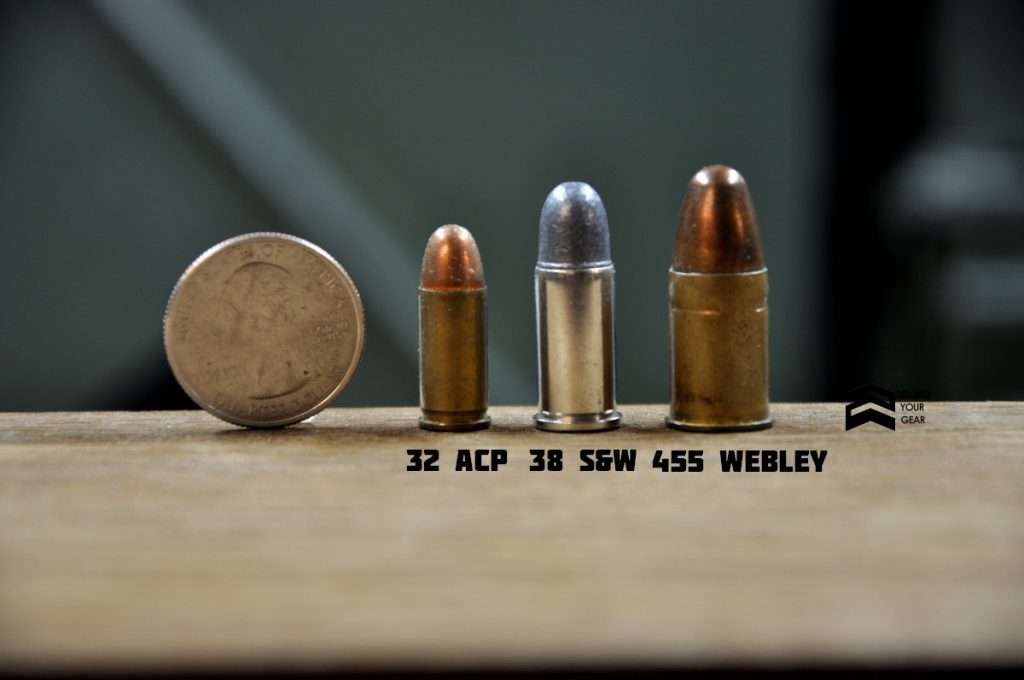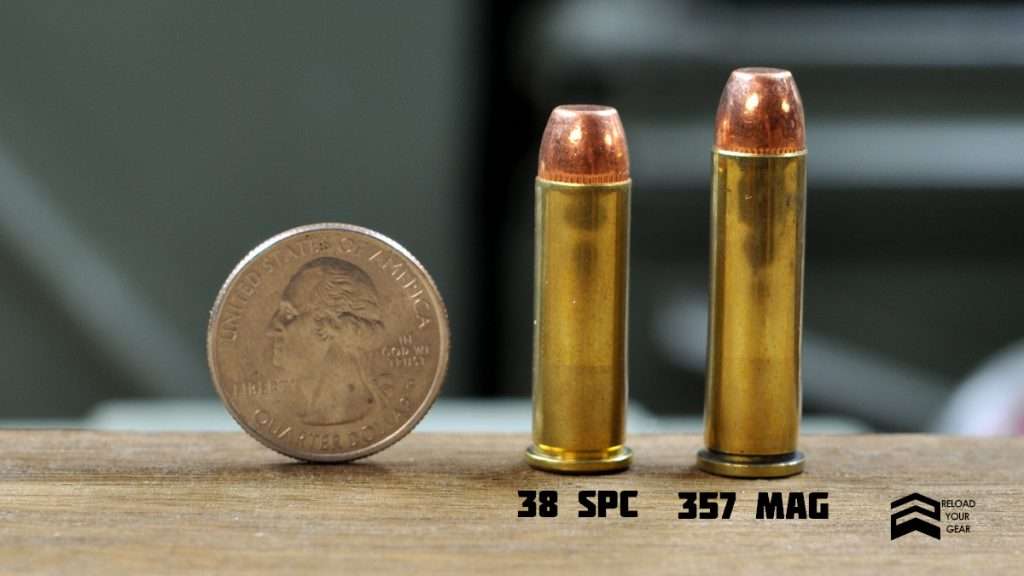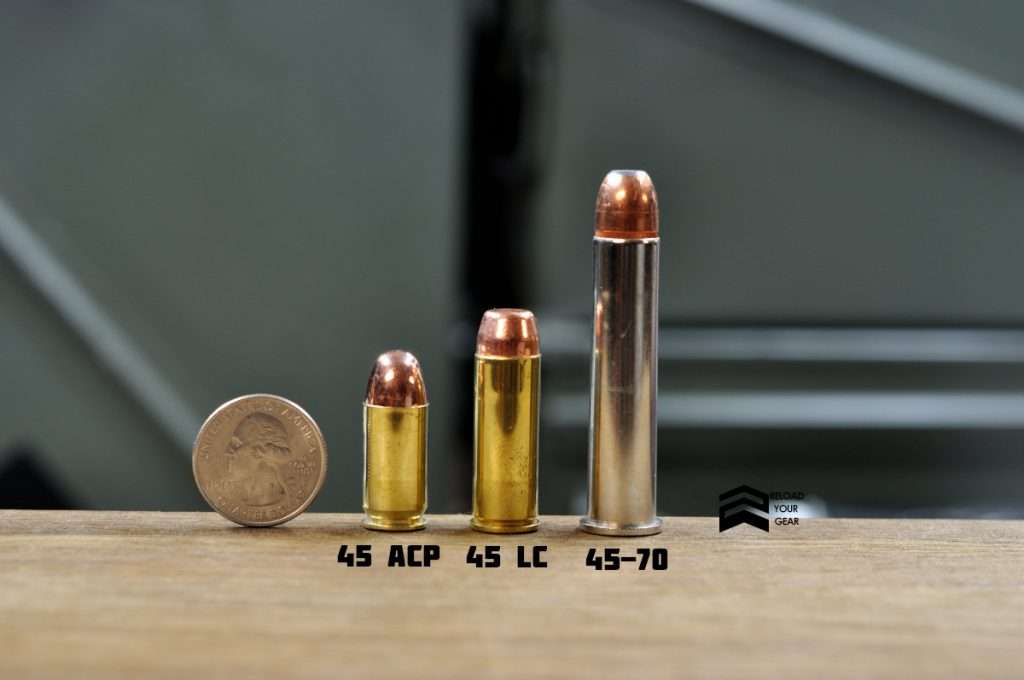
There are so many pistol calibers out there. How do you pick the right one . . . or three? 😉 Our handgun caliber comparison (really cartridges) will go through the performance details and help you understand the differences.
What is a Caliber?
Caliber is the diameter of a bullet at its widest point. Calibers units are classified into Imperial (inches) and Metric (millimeters). For example, the 32 Auto has a bullet diameter of .32 inches, while the 9mm Luger has a 9mm bullet diameter. Often, the actual diameter will be rounded from a third digit such as .451 and is just shortened for convenience.
Handgun Cartridge (Caliber) Comparison
These numbers are from Federal and specified for FMJ or JSP as available, nominal temperatures, 10 mph wind, sea level, 0.9 in sight height, and a 25 yd zero. Strictly speaking, the caliber of a bullet is unrelated to the cartridge itself and the overall length of the round. But, these cartridge names are closely associated with particular case dimensions, loading, and bullet sizes to make compatibility with guns more obvious and easier to talk about using shorthand.
| Cartridge Name | Most Common Bullet Weight | Drop at 50 yds (in) | Wind Drift at 50 yds (in) | Muzzle Velocity (fps/mps) | Muzzle Energy (Ft-Lb/J) | 25 yd Energy (Ft-Lb/J) |
|---|---|---|---|---|---|---|
| 9mm NATO | 124 grs | -0.6 | -1.3 | 1260 / 384 | 437 / 592 | 349 / 464 |
| 32 Auto | 71 grs | -2.0 | 0.9 | 899 / 274 | 127 / 172 | 120 / 161 |
| 380 Auto | 95 grs | -1.6 | 1.3 | 980 / 299 | 203 / 275 | 185 / 249 |
| 38 Special | 130 grs | -2 | 0.7 | 890 / 271 | 229 / 309 | 219 / 294 |
| 357 magnum | 158 grs | -0.6 | 1.0 | 1240 / 378 | 539 / 731 | 494 / 666 |
| 40 S&W | 155 grs | -0.9 | 1.3 | 1160 / 354 | 463 / 629 | 413 / 556 |
| 10 mm | 180 grs | -1.3 | 0.8 | 1030 / 314 | 424 / 575 | 398 / 537 |
| 44 Magnum | 240 grs | -0.6 | 1.1 | 1270 / 387 | 859 / 1165 | 772 / 1039 |
| 45 Auto | 230 grs | -2.2 | 0.7 | 860 / 262 | 378 / 512 | 364 / 491 |
| 45 LC | 225 grs | -2.2 | 0.7 | 860 / 262 | 369 / 500 | 356 / 481 |
Handgun Bullet Types
Handgun cartridges come loaded with a variety of bullet shapes, each tailored for a purpose. You can find anything from full metal jackets (FMJ) to wadcutters and everything in between. And in a lot of scenarios, the lines blur a bit, and it’s hard to really say which classic category a bullet fits the best. But, here are the common ones.
Full Metal Jacket (FMJ)
Full metal jacketed bullets are typically copper-jacketed lead bullets. They feature a slower, controlled expansion for greater penetration.
Jacketed Hollow Points (JHP)
Jacketed Hollow Points are copper clad but maintain a void at the tip of the bullet for faster expansion when striking soft targets. They’re most commonly used for self-defense scenarios and sometimes hunting.
Soft Points
Soft point bullets generally use a rounded, lead tip to quickly mushroom out and transfer energy into the target for balanced expansion and penetration.
Wadcutters
Wadcutter rounds are normally used for large, slow moving bullets and got their name for the neat holes they made in paper targets. Their aerodynamics are terrible, so they’re rarely used beyond handgun range. Most of the practical bullets that you’ll find are listed as SWC or Semi-Wadcutters. But with so much weight behind every part of the bullet, they have high penetration and significant knock-down power.
Bullet Components
This may go without saying for those that are familiar, but it’s here for completeness. Pistol cartridges are made out of 4 components from tip to rear: a bullet, a case, powder, and a primer. Here’s a deconstructed a 9 mm.

That’s with a FMJ bullet. And here’s a cross-section of a bullet.

Handgun Caliber Guide
9mm Luger

The 9mm Parabellum, famously known as 9mm Luger, is the most popular military pistol calibers in the world.
Since being introduced in 1902 and quickly being adopted by the German military, it has really taken off. Every major US manufacturer offers a pistol in 9 mm.
Aside from its efficiency and a muzzle velocity of 360 m/s (115-gr bullet), the 9mm is also very affordable and has mild recoil which makes accurate follow up shots easier. Reloading is easy, and the ballistic data is great too. It also has minimal wind drift and drop out to 50 yards, which will keep you on target with little thought.

It’s also used by the majority of law enforcement agencies in the country, including the FBI. In 2014, the FBI stated that the 9mm is more effective in combat than the .45 ACP and .40 S&W.

.32 Auto

The .32 Automatic Colt Pistol (ACP) or .32 Auto is a light-kicking, less common cartridge that’s decent for concealed carry and is easy to shoot for new or young shooters. It’s also known as the 7.65 mm Browning.
The .32 Auto usually chambers in lightweight and compact pistols that are suitable for concealed carry. Since it has low pressure, it’s easy to use in a variety of pistol designs. Some gun owners think that this caliber is not powerful enough to be used for self-defense, while others prefer this round because it comes with small, easily concealable guns. Size aside, a 71-gr bullet propelled by the.32 Auto is powerful enough to travel at a speed of 274 meters per second, yielding 172 Joules of muzzle energy.
Overall, the .32 Auto is a reasonable cartridge choice for your CCW or your backup gun.
.380 Auto

Despite its short efficiency range and low stopping power, the .380 Auto is compact and light, so it’s a popular cartridge choice for pocket guns.
This is yet another cartridge designed by the legendary John Browning in 1912.
This one goes by a variety of names, so be careful when you’re picking up ammo. It’s also known as the 9 mm Court, 9 mm Kurz, 9 mm Browning Short, or 9 x 17 mm.
The .380 Auto generates greater muzzle energy than the .32 Auto and has less bullet drop , but is less powerful than the 9mm Luger. Some gun “experts” don’t recommend it as a self-defense round because it lacks penetration power.
.38 Special

First produced in 1902, the .38 Special is a popular revolver round. It’s more powerful but is slower than the last two calibers we discussed, with a muzzle velocity of only 271 m/s (130-gr).
This low-pressure round is commonly used for concealed carry and self-defense because of its accuracy and manageable recoil. One downside of the .38 Special is that it doesn’t always expand well, particularly if fired from a short-barreled revolver.
But with it’s popularity, there are a load of bullets available for every purpose.
.357 Magnum
In 1934, Smith & Wesson wanted to develop a cartridge more powerful and with a longer case length than the .38 Special, which led to the birth of the .357 Magnum.

As one of the most powerful rounds today, the .357 Magnum yields 780 Joules of energy at the muzzle and can fire a 125-gr bullet at 439 meters per second. That’s why it’s a famous round among cops for their backup guns; and civilians love to use it for self-defense, target shooting, and hunting. It’s been used to take game up to deer size.
As for its recoil, it becomes manageable when shot from a medium-frame revolver.
10 mm Auto

The 10mm Auto is a lightweight but powerful cartridge that was used by the FBI during the ’80s but was replaced shortly due to its increased recoil. It was born out of a desire to increase the power of the 9mm Luger and 38 Super.
The original cartridge used a cut-off 30 Remington cases with a 40 caliber bullet from a 38-40 Winchester. Colt jumped in with a M1911, and it looked like it’d catch on. But, other cartridges have provided quality alternatives.

The 10mm Auto also excels in terms of speed as its fired 180-grain bullet travels at 314 meters per second. This flat-shooting cartridge is also widely used as a hunting and self-defense round because it delivers deep penetration.
.40 S&W

Inspired by the 10mm cartridge’s potential, Winchester and Smith & Wesson developed a cartridge with the same performance, initially intended for law enforcement use. It’s close to the length of 9 mm Luger and the performance can push 45 Auto.
The .40 S&W performs almost similar to the 9mm Ruger in terms of drop and wind drift at 25 yards, as well as muzzle velocity. But when it comes to muzzle energy, the .40 S&W is the obvious winner, yielding 629 Joules energy when firing a 155-grain bullet.

The .40 S&W also has better penetration than the 9mm because it loads wide and flat bullets. However, because of its power, .40 S&W-loaded guns throw nasty recoils so they’re brutal to fire.
.44 Magnum

Ahh, Dirty Harry and his 44 Mag, “the most powerful handgun in the world”. The .44 Magnum can send a 180gr bullet flying at a speed of 441 meters per second, yielding muzzle energy of 1,155 Joules! I would not shoot this one one-handed personally, but that’s your choice. “I gots to know” if you feel man enough.

This large-bore cartridge is capable of bringing a bear to its demise because of its precise shot placement and deep penetrating power. And while it’s true that there are more powerful rounds out there like the .460 S&W Magnum, the .44 Magnum has more controllable recoil.
The 44 Magnum was introduced in 1955 by Remington and Smith and Wesson. It’s been used in anything from revolvers to carbines for shooting and especially hunting, taking anything from deer to elk and bear.
.45 Auto

If you’re one of those guys who wants to find out which is more powerful between the .45 Auto and the 9mm, here’s what you need to know.
This is another cartridge by John M. Browning and was adopted by the US military in 1911.
The .45 Auto or sometimes called the .45 ACP (although that’s the name for the pistol) produces a muzzle energy of 548 Joules, while the 9mm only yields 483 Joules energy. Don’t get us wrong, the 9mm is powerful enough to kill a large-sized game (read “home invaders”), and it definitely fires faster bullets than the .45, it’s just that the .45 ACP delivers more fatal blows.

However, if capacity is your priority and you prefer small-caliber bullets, you should consider getting a 9mm. That’s settled, then.
.45 LC

OK, so the long Colt memes are a bit thin . . . .
Originally developed as a black-powder revolver cartridge, the .45 Long Colt (LC) functioned as the official US military handgun from 1873 to 1887.

The .45 Colt possesses almost the same ballistics as the .45 ACP. Its 225-grain bullet has a muzzle velocity of 262 meters per second, generating 500 Joules muzzle energy. That’s a small decrease from the .45 ACP’s 271 meters per second muzzle velocity and 548 Joules energy at the muzzle for a 230-gr bullet.
FAQs
What Is The Largest Caliber Handgun?

The 600 Nitro Express is the largest caliber handgun in the world with a bullet length of 3.68 inches. That’s why it’s usually used for hunting extremely large-sized game in Africa such as elephants.
What Is The Most Accurate Handgun Caliber?

Among our listed handgun calibers above, the .357Magnum gets the spot as the most accurate. As it only drops by 0.6 in at 50 yards and only drifts by 1 in at the same distance.
More importantly though, can you shoot it without flinching? Magnum cartridges tend to pack a punch!
What Is The Most Powerful Handgun Caliber?
When it comes to power, the 600 Nitro Express is the most powerful as a curio gun. Out of the most popular handgun calibers, 45 ACP takes the cake.
Just look at this guy trying to handle the 600 Nitro in a handgun.
What Is The Best Caliber For A Handgun?
The .44 Magnum has accuracy, speed, and power. But, capacity and recoil considerations lead many to choose 9 mm or something more practical for day to day use.
What Is The Best Handgun Caliber For Self-defense?

If you prefer compact and lightweight pistols for easy concealment and don’t care much about penetration power, we recommend the 9 mm as the best handgun caliber for self-defense. Although, the 380 is great for easy concealment.
Conclusion
Now you’re ready to start shooting! Remember, always use the correct ammo for your gun and refer to our guide above or seek professional help whenever you’re uncertain. And never experiment on loading other calibers that are not recommended for your firearm, even if they fit into your magazine, as this may lead to accidents. If you’re also reloading rifle cartridges, our ultimate rifle caliber comparison is a great place to start!
If you own a 1911 pistol, improve your accuracy with these 1911 red dot sights and mounts.
